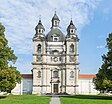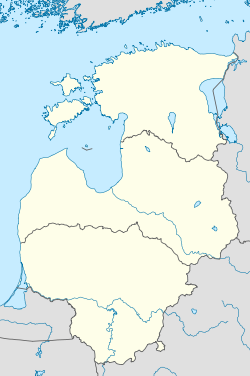
Back Kaunas Afrikaans ካውናስ Amharic Kaunas AN كاوناس Arabic كاوناس ARZ Kaunas AST Kaunas AVK Kawnas Aymara Kaunas Azerbaijani Kauns BAT-SMG
Kaunas | |
|---|---|
City | |
|
| |
| Nickname(s): | |
| Motto(s): | |
 Interactive map of Kaunas | |
| Coordinates: 54°53′50″N 23°53′10″E / 54.89722°N 23.88611°E | |
| Country | |
| County | Kaunas County |
| Municipality | Kaunas city municipality |
| Capital of | Kaunas County |
| First mentioned | 1361 |
| Granted city rights | 1408 |
| Elderships | |
| Government | |
| • Type | Mayor-council government |
| • Mayor of Kaunas | Visvaldas Matijošaitis (2015-)[3] |
| Area | |
• City | 157 km2 (61 sq mi) |
| • Urban | 1,653 km2 (638 sq mi) |
| • Metro | 8,086 km2 (3,122 sq mi) |
| Elevation | 48 m (157 ft) |
| Population (2024) | |
• City | 304,210 |
| • Density | 1,903/km2 (4,930/sq mi) |
| • Urban | 403,375[6] |
| • Urban density | 230/km2 (600/sq mi) |
| • Metro | 623,262[4][5] |
| • Metro density | 77/km2 (200/sq mi) |
| Demonym(s) | Kaunian(s) (English) kauniečiai (Lithuanian) |
| GDP | |
| • Metro | €14.7 billion (2023) |
| Time zone | UTC+2 (EET) |
| • Summer (DST) | UTC+3 (EEST) |
| Postal code | 44xxx – 52xxx |
| Area code | (+370) 37 |
| City budget | €680 million[8] |
| Climate | Dfb |
| Website | www.kaunas.lt |
| Official name | Modernist Kaunas: Architecture of Optimism, 1919-1939 |
| Type | Cultural |
| Criteria | iv |
| Designated | 2023 (45th session) |
| Reference no. | [9] |
| UNESCO region | Europe |
Kaunas (/ˈkaʊnəs/; Lithuanian: [ˈkɐʊ̯ˑnˠɐs] ⓘ; previously known in English as Kovno /ˈkɒvnoʊ/) is the second-largest city in Lithuania after Vilnius, the fourth largest city in the Baltic States and an important centre of Lithuanian economic, academic, and cultural life.[10] Kaunas was the largest city and the centre of a county in the Duchy of Trakai of the Grand Duchy of Lithuania and Trakai Palatinate since 1413. In the Russian Empire, it was the capital of the Kaunas Governorate from 1843 to 1915.[10]
During the interwar period, it served as the temporary capital of Lithuania, when Vilnius was seized and controlled by Poland between 1920 and 1939. During that period Kaunas was celebrated for its rich cultural and academic life, fashion, construction of countless Art Deco and Lithuanian National Revival architectural-style buildings as well as popular furniture, interior design of the time, and a widespread café culture.[1] The city interwar architecture is regarded as among the finest examples of European Art Deco and has received the European Heritage Label.[11][12] It contributed to Kaunas being designated as the first city in Central and Eastern Europe as a UNESCO City of Design,[13][14][15] and also to becoming a World Heritage Site in 2023 as the only European city representing large scale urbanization during the interwar period and versatile modernism architecture.[16]
Kaunas was selected as the European Capital of Culture for 2022, together with Esch-sur-Alzette and Novi Sad.[17][18]
The city is the capital of Kaunas County, and the seat of the Kaunas city municipality and the Kaunas District Municipality. It is also the seat of the Roman Catholic Archdiocese of Kaunas. Kaunas is located at the confluence of the two largest Lithuanian rivers, the Nemunas and the Neris, and is near the Kaunas Reservoir, the largest body of water in the whole of Lithuania.
As defined by Eurostat, the population of Kaunas functional urban area, is estimated at 391,153 (as of[update] 2021),[19] while according to statistics of Kaunas territorial health insurance fund, there are 447,946 permanent inhabitants (as of 2022) in Kaunas and Kaunas district municipalities combined.[20][21] Moreover, the tertiary education institutions of Kaunas attract thousands of students annually.[22]
- ^ a b "Kodėl Kaunas buvo vadinamas mažuoju Paryžiumi?". lrytas.lt (in Lithuanian). Retrieved 3 January 2013.
- ^ Raffa, Guy P. (2009). The Complete Danteworlds: A Reader's Guide to the Divine Comedy. University of Chicago Press. ISBN 978-0226702872.
- ^ "Kaunas city municipality – Mayor's office". Kaunas city municipality. Retrieved 7 June 2018.
- ^ with Kaunas county
- ^ "Kauno teritorinė ligonių kasa - Prisirašiusių gyventojų skaičius" (in Lithuanian). Retrieved 7 December 2022.
- ^ "Eurostat". eurostat.ec.europa.eu.
- ^ "Bendrasis Vidaus Produktas Pagal Apskritis 2022 M." osp.stat.gov.lt.
- ^ "Kviečiame susipažinti su 2024 m. Kauno miesto biudžetu".
- ^ "Modernist Kaunas: Architecture of Optimism, 1919-1939". UNESCO World Heritage Centre. Retrieved 18 September 2023.
- ^ a b "Kaunas". Visuotinė lietuvių enciklopedija (in Lithuanian). Retrieved 5 October 2024.
- ^ Cite error: The named reference
EHLwas invoked but never defined (see the help page). - ^ Cite error: The named reference
EHL2was invoked but never defined (see the help page). - ^ Bryant, Jon (8 September 2016). "10 of the best European cities for art deco design". The Guardian. Retrieved 8 September 2016.
- ^ "Art Deco Kaunas". ArtDecoKaunas.lt. Retrieved 4 November 2017.
- ^ "Kaunas – Cities of Design Network". DesignCities.net. Retrieved 4 November 2017.
- ^ "Kauno tarpukario architektūra įrašyta į UNESCO Pasaulio paveldo sąrašą". Lithuanian National Radio and Television (in Lithuanian). 18 September 2023. Retrieved 18 September 2023.
- ^ "Kaunas European Capital of Culture 2022". Kaunas2022.eu. 21 January 2016. Archived from the original on 8 December 2017. Retrieved 7 December 2017.
- ^ "European Capitals of Culture". Retrieved 8 May 2022.
- ^ "Population on 1 January by age groups and sex - functional urban areas". Eurostat. Retrieved 15 June 2019.
- ^ "Gyventojų skaičius » Kauno teritorinė ligonių kasa". www.ktlk.lt.
- ^ "Kauno teritorinė ligonių kasa - Prisirašiusių gyventojų skaičius" (in Lithuanian). Retrieved 9 December 2022.
- ^ Cite error: The named reference
Studentswas invoked but never defined (see the help page).












